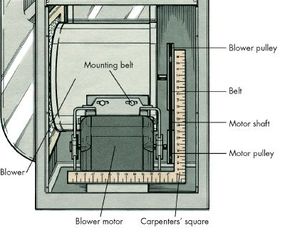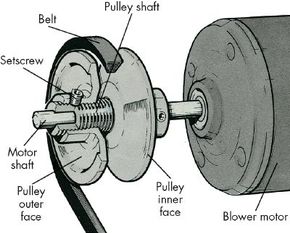Adjusting the Blower Speed
An increase in blower speed can sometimes improve the flow of warm air through your home. A decrease can make the system quieter. You can increase or decrease the blower speed by slightly adjusting the pulley on the blower drive motor.
To increase blower speed, slightly loosen the setscrew that holds the pulley to the driveshaft. Move or turn the pulley clockwise on the shaft one turn, then tighten setscrew. If more speed is desired, turn the pulley clockwise two turns.
Advertisement
For decreasing blower speed, loosen the setscrew that holds the pulley to the driveshaft. Move or turn the pulley counterclockwise on the driveshaft one turn, then tighten the setscrew. If less speed is desired, turn the pulley counterclockwise two turns.

The motor and blower pulley may also get out of alignment. This causes the blower to be noisy and cuts down on the efficiency of your distribution system. To check alignment, place a carpenters' square against the outside of the motor and blower pulleys. The pulleys should be in a straight line and at right angles to the motor shaft.
If the pulleys are not lined up at right angles to the motor housing, loosen the setscrew holding the motor pulley and move the pulley backward or forward as needed to align it properly. If the setscrew is jammed or rusted and won't loosen or if the pulleys are out of alignment, loosen the mounting bolts on the motor and slide the motor backward or forward until the pulleys are properly aligned.
Noise and heat loss from ducts are common problems with forced-air distribution systems. In the next section, we'll discuss how to solve these issues.
